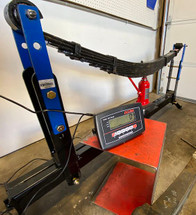
Leaf Spring Testing
Leaf Spring Rate Testing - Ford F53 OEM vs Aftermarket
A common complaint on some motorhome chassis such as the F53 is rough ride. When thinking of ways to address ride quality issues, people often look to the shock absorbers. While shock absorbers can be a key component to improving upon a rough ride, they are not the only part of the system to consider.
The springs themselves can have a lot to do with the softness or harshness of the ride. The shock absorbers are there to control (dampen) movement of the body relative to the axle (and vice-versa), but the springs themselves are carrying the weight of the coach and taking the impact of bumps and potholes. If the springs are too stiff then more of the force of impact from road roughness will be transmitted through the springs into the chassis of the coach, where it will be perceived by the driver as a rough ride.
"Our goal is to prove the value of any RV product before we offer it to the market"
Stiffness in springs is measured by spring rate, which refers to the amount of force required to compress the spring by a given distance (in the US, typically pounds per inch of compression). To achieve the best ride quality, we want to keep the spring rate as low as possible while still carrying the weight of the coach at proper ride height.
For this reason, our R&D Department at SuperSteer is in the process of testing the spring rate of OEM leaf springs vs aftermarket options, with the goal of offering a tested and validated option for improving ride quality. We are still in the early stages of this project but we are excited to introduce it!
This is not the only R&D project we have in the works – look forward to future articles sharing more details on how the SuperSteer team is working to bring out more products for safer and happier driving. After all, our goal is to prove the value of any RV product before we offer it to the market!
